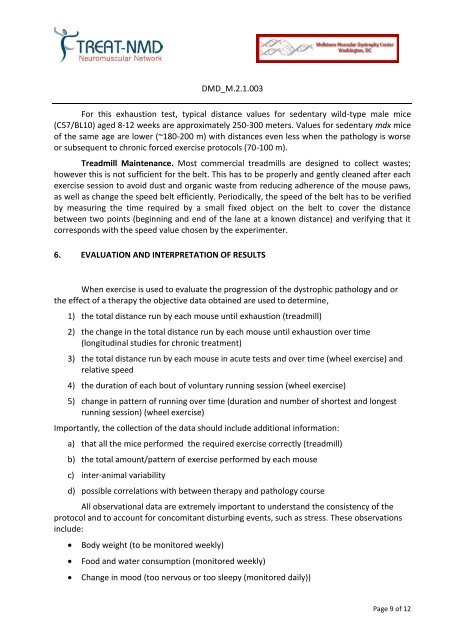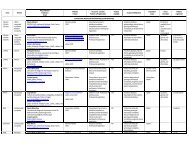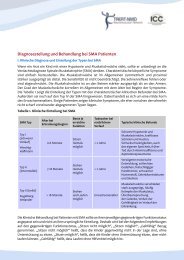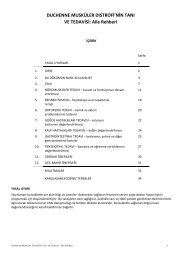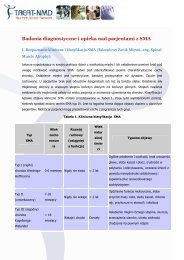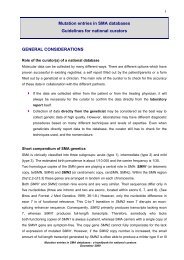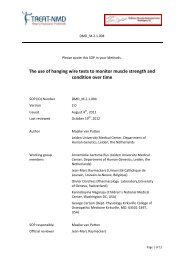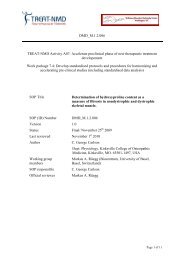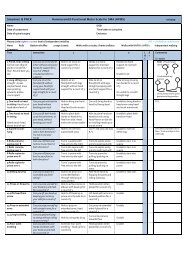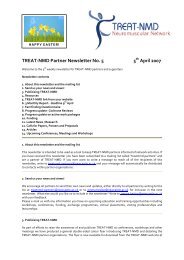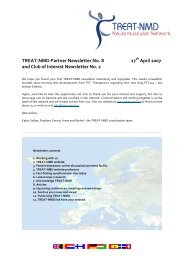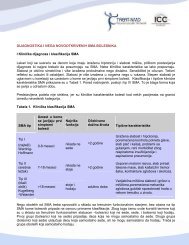Use of treadmill and wheel exercise to assess ... - Treat-NMD
Use of treadmill and wheel exercise to assess ... - Treat-NMD
Use of treadmill and wheel exercise to assess ... - Treat-NMD
You also want an ePaper? Increase the reach of your titles
YUMPU automatically turns print PDFs into web optimized ePapers that Google loves.
DMD_M.2.1.003<br />
For this exhaustion test, typical distance values for sedentary wild-type male mice<br />
(C57/BL10) aged 8-12 weeks are approximately 250-300 meters. Values for sedentary mdx mice<br />
<strong>of</strong> the same age are lower (~180-200 m) with distances even less when the pathology is worse<br />
or subsequent <strong>to</strong> chronic forced <strong>exercise</strong> pro<strong>to</strong>cols (70-100 m).<br />
Treadmill Maintenance. Most commercial <strong>treadmill</strong>s are designed <strong>to</strong> collect wastes;<br />
however this is not sufficient for the belt. This has <strong>to</strong> be properly <strong>and</strong> gently cleaned after each<br />
<strong>exercise</strong> session <strong>to</strong> avoid dust <strong>and</strong> organic waste from reducing adherence <strong>of</strong> the mouse paws,<br />
as well as change the speed belt efficiently. Periodically, the speed <strong>of</strong> the belt has <strong>to</strong> be verified<br />
by measuring the time required by a small fixed object on the belt <strong>to</strong> cover the distance<br />
between two points (beginning <strong>and</strong> end <strong>of</strong> the lane at a known distance) <strong>and</strong> verifying that it<br />
corresponds with the speed value chosen by the experimenter.<br />
6. EVALUATION AND INTERPRETATION OF RESULTS<br />
When <strong>exercise</strong> is used <strong>to</strong> evaluate the progression <strong>of</strong> the dystrophic pathology <strong>and</strong> or<br />
the effect <strong>of</strong> a therapy the objective data obtained are used <strong>to</strong> determine,<br />
1) the <strong>to</strong>tal distance run by each mouse until exhaustion (<strong>treadmill</strong>)<br />
2) the change in the <strong>to</strong>tal distance run by each mouse until exhaustion over time<br />
(longitudinal studies for chronic treatment)<br />
3) the <strong>to</strong>tal distance run by each mouse in acute tests <strong>and</strong> over time (<strong>wheel</strong> <strong>exercise</strong>) <strong>and</strong><br />
relative speed<br />
4) the duration <strong>of</strong> each bout <strong>of</strong> voluntary running session (<strong>wheel</strong> <strong>exercise</strong>)<br />
5) change in pattern <strong>of</strong> running over time (duration <strong>and</strong> number <strong>of</strong> shortest <strong>and</strong> longest<br />
running session) (<strong>wheel</strong> <strong>exercise</strong>)<br />
Importantly, the collection <strong>of</strong> the data should include additional information:<br />
a) that all the mice performed the required <strong>exercise</strong> correctly (<strong>treadmill</strong>)<br />
b) the <strong>to</strong>tal amount/pattern <strong>of</strong> <strong>exercise</strong> performed by each mouse<br />
c) inter-animal variability<br />
d) possible correlations with between therapy <strong>and</strong> pathology course<br />
All observational data are extremely important <strong>to</strong> underst<strong>and</strong> the consistency <strong>of</strong> the<br />
pro<strong>to</strong>col <strong>and</strong> <strong>to</strong> account for concomitant disturbing events, such as stress. These observations<br />
include:<br />
<br />
<br />
<br />
Body weight (<strong>to</strong> be moni<strong>to</strong>red weekly)<br />
Food <strong>and</strong> water consumption (moni<strong>to</strong>red weekly)<br />
Change in mood (<strong>to</strong>o nervous or <strong>to</strong>o sleepy (moni<strong>to</strong>red daily))<br />
Page 9 <strong>of</strong> 12


